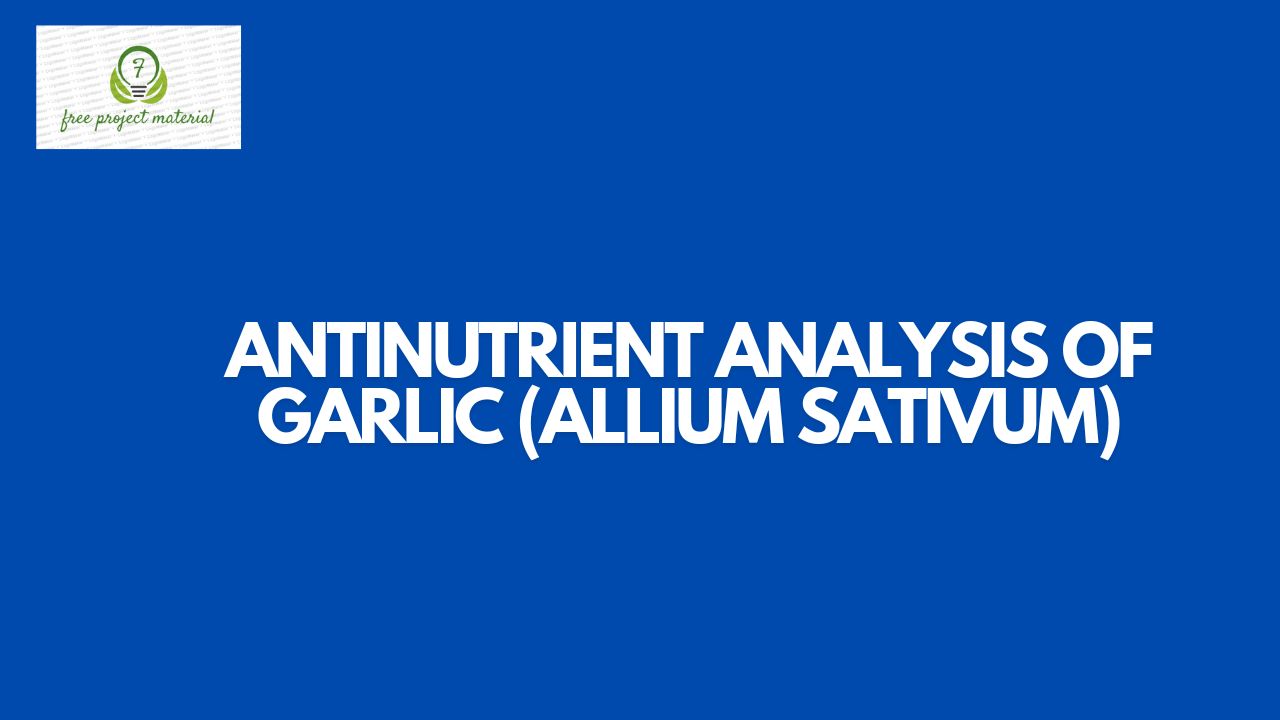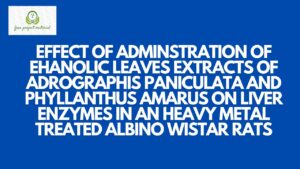This project is about the Antinutrient analysis of garlic (Allium sativum), It is suitable for final year research project
work for both Polytechnic and University Undergraduate. The project is made up
of 5 chapters, well arranged and have been properly vetted by qualified
lecturers and presented in accredited recognized tertiary institutions
ABSTRACT
Antinutritional factors are compounds or substance which act to reduce nutrient intake, digestion, absorption and utilization. Nutritional factors are substances that provide nourishment essential for the maintenance of life and growth. Some of the common symptoms exhibited by a large amount of antinutrients in the body can be nausea, bloating, headaches, nutritional deficiencies etc. This study was carried out to investigate the antinutrients content of garlic as a preliminary work to evaluate the influence of garlic on nutrient absorption. Garlic bulb (Allium sativum), including cloves were obtained from Abiakpo Ntak Iyang’s market, Ikot Osurua, Ikot Ekpene. The garlic bulbs were desegmented into cloves, peeled, washed and cut into chips. The chips were sun- dried, ground and analyzed for the antinutrients composition. The result obtained indicated that garlic contained 0.79 0.50%, 12.99 0.12mg/100g, 4.70 0.18mg/100g, 6.70 0.37mg/100g and 2.73 0.33mg/L of saponins, hydrogen cyanide (HCN), tannins, phytate and oxalate respectively. These antinutritional factors interfere with nutrient absorption and also have some adverse effects in the body. The negative influences of these antinutrients can be reduced by cooking the garlic before consumption.
TABLE OF CONTENTS
Title Page – – – – – – – – – i
Certification – – – – – – – – ii
Dedication – – – – – – – – iii
Acknowledgment – – – – – – – iv
Abstract – – – – – – – – – v
Table of Content – – – – – – – – vi
CHAPTER ONE: INTRODUCTION
1.1 Background of the Study – – – – – 1
1.2 Aim and Objectives – – – – – – 3
1.3 Scope and Limitation – – – – – – 4
1.4 Significance of the Study – – – – – 4
CHAPTER TWO: LITERATURE REVIEW
2.1 Allium sativum – – – – – – – 5
2.1.1 General Description – – – – – – 5
2.1.2 Botanical Classification – – – – – 6
2.2 Uses of Allium sativum – – – – – 7
2.2.1 Culinary Uses – – – – – – – 7
2.2.2 Traditional Uses – – – – – – – 9
2.3 Pharmacological Activities – – – – – 10
2.4 Chemical Constituent – – – – – – 21
2.5 Nutritional Composition – – – – – 23
2.6 Recommended Dose – – – – – – 25
2.7 Toxicity and Adverse Effect – – – – – 26
2.8 Antinutritional Factors – – – – – – 28
2.8.1 Tannins – – – – – – – – 28
2.8.2 Saponins – – – – – – – – 29
2.8.3 Hydrogen cyanide (HCN) – – – – – 30
2.8.4 Oxalate – – – – – – – – 31
2.8.5 Phytate – – – – – – – – 31
CHAPTER THREE: MATERIALS AND METHODS
3.1 Materials and Reagent Used – – – – – 34
3.2 Methods – – – – – – – – 34
3.2.1 Collection and Preparation of Plant Sample – – 34
3.3 Determination of Antinutrients in Plant Sample – – 35
3.3.1 Determination of Tannins – – – – – 35
3.3.2 Determination of Saponins – – – – – 36
3.3.3 Determination of HCN – – – – – – 37
3.3.4 Determination of Oxalate – – – – – 38
3.3.5 Determination of Phytate – – – – – 38
CHAPTER FOUR: RESULTS AND DISCUSSION
4.1 Results – – – – – – – – 40
4.2 Discussion – – – – – – – – 41
CHAPTER FIVE: CONCLUSION AND RECOMMENDATION
5.1 Conclusion – – – – – – – – 43
5.2 Recommendation – – – – – – 44
References
CHAPTER ONE: INTRODUCTION
1.1 Background of the Study
Antinutrients are natural or synthetic compounds that interfere with the absorption of nutrients (Cammack et al., 2006). Nutrition studies focus on antinutrients commonly found in food sources and beverages. Antinutrients may take the form of drugs, chemicals, that naturally occur in food sources, proteins, or over consumption of nutrients themselves. Antinutrients may act by binding to vitamins and minerals, preventing their uptake, or inhibiting enzymes.
Throughout history, humans have bred crops to reduce antinutrients, and cooking processes have developed to remove them from raw food materials and increase nutrient bioavailability, notably in staple foods such as cassava.
Garlic is a vegetable plant, a bulb belonging to Liliaceae. It is the most important preventive herb, a spice, a well trusted remedy during the various epidemics such as dysentery, typhoid, cholera and influenza (Gopak et al., 2005). It is an effective remedy for a variety of ailments. Garlic contains at least 100 sulphur-containing compounds basic to medicinal uses with Allicin representing 20 to 80 percent of the total thiosulphates found in it (Kishu, 2009). It has a slight imperceptive smell until it has been peeled. Once peeled sliced or crushed, it immediately begins to spread an intense smell that contains sulphur glycosides. Many studies have indicated that allicin is the most important component of garlic that is responsible to its characteristics colour, flavor as well as most of its biological properties (Chowdhury et al., 2002; Durak et al., 2002; Heinrich et al., 2004; Shalaby et al., 2006).
Despite its high medicinal and culinary value, garlic contains some antinutritional factors such as saponins, tannin, and hydrogen cyanide (Okaka and Okaka, 2001). Saponins and tannin contents of garlic are within the range of 0.14 to 19.0% and 0.06 to6.10% respectively (Friday et al., 2011). Although uncommon, allergic reactions of garlic have been reported with various symptoms such as difficult breath, closing of the throat and swelling of the lips, tongue or face. Other symptoms especially in raw garlic consumption include burning of the mouth, throat and stomach, diarrhea, sweating, nausea or vomiting, light headedness eczema or a rash, redness/swelling/blistering when applied to the skin, easy bruising or bleeding (nosebleed, bleeding gums), unpleasant breath or body odour (Borek, 2005).
1.2 Aim and Objectives
Aim
This study was aimed at determining the antinutrient contents of garlic
Objectives
The following were the objectives of the study
- To determine the tannin content of garlic
- To determine the hydrogen cyanide content in garlic
- To determine the oxalate content in garlic
- To determine the phytate content in garlic
- To determine the saponin content in garlic
1.3 Scope and Limitation
This study was limited to the determination of antinutrient content of garlic only due to time and financial constraint.
1.3 Significance of the Study
This project is of significance in the sense that
It will help consumers to know the antinutrient content of garlic
It will also help to know the effects of consuming much of it.



